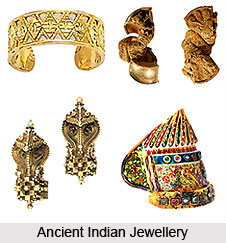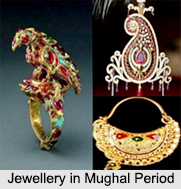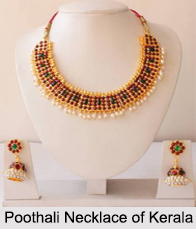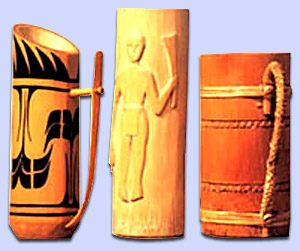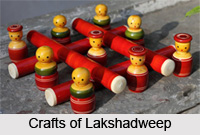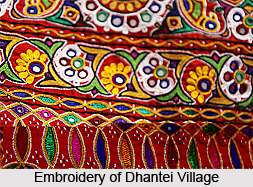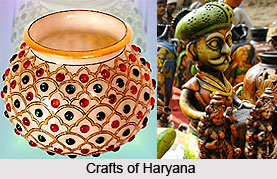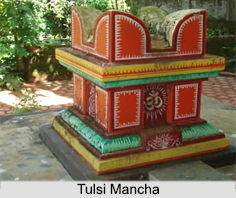 Terracotta Tulsi Mancha is a prominent example of Hindu culture and folk art of West Bengal. It is a pedestal, on which Tulsi, the sacred Hindu plant, is planted and worshipped by the housewives in villages of Bengal. Prayers are offered every day at dusk by illuminating lamps in front of the Mancha. They are set on a pre-decided place in every village home. Generally, Tulsi Manchas are of two types- clay pedestal or pedestal built by bricks, lime and sand. Mostly clay pedestals are built by those who can"t afford the bricks pedestals. Some time, writings are inscribed on the outer surface of the Tulsi Mancha. Tulsi Manchas can still be found in the districts of Bankura and Medinipur.
Terracotta Tulsi Mancha is a prominent example of Hindu culture and folk art of West Bengal. It is a pedestal, on which Tulsi, the sacred Hindu plant, is planted and worshipped by the housewives in villages of Bengal. Prayers are offered every day at dusk by illuminating lamps in front of the Mancha. They are set on a pre-decided place in every village home. Generally, Tulsi Manchas are of two types- clay pedestal or pedestal built by bricks, lime and sand. Mostly clay pedestals are built by those who can"t afford the bricks pedestals. Some time, writings are inscribed on the outer surface of the Tulsi Mancha. Tulsi Manchas can still be found in the districts of Bankura and Medinipur.
Structure of Tulsi Mancha
Tulsi Manchas are usually between 45 to 90 cm in height and the length of each side varies between 45 and 60 cm. The thickness of the walls is between one and two cm. Most of the time, Tulsi Mancha is either spherical or square-shaped and the central portion of the roof was connected to the top section of a pitcher, which is locally known as "moka". The lower part of the "mancha" is always kept hollow to help the plant in spreading its roots easily.
Types of Tulsi Mancha
Tulsi Mancha is temple shaped pedestal, on the top of which Tulsi is planted; sometimes, it is made with several brick steps. Often, an idol of elephant is made to place near the Mancha on the back of the idol. Another type of Tulsi Mancha is "Harisabha" or "Harimandir", which is created by placing five temple-shaped Tulsi Manchas together to put in the courtyards of a special type of domestic house. A larger Tulsi Mancha is kept in the center whereas four smaller Manchas are placed at the four corners of it. These kinds of Manchas are seen in the villages of Medinipur district. Another type of Tulsi Mancha having a shape of square, or hexagonal or octagonal is also a fine specimen of folk art with terracotta designs on it. This type of Mancha is produced by the potter community of Panshkurhajamluk, Sutahata and Kharagpur. Along with this, circular shaped Tulsi Mancha can also be seen in some places.
Designs and Motifs on Tulsi Mancha
Several designs and motifs are engraved on the walls of the Mancha to decorate it for the sake of enhancing its beauty. For example, the idols of Hindu Gods and Goddesses like Gour-Nitai, Radha-Krishna, Jagannath-Balaram-Subhadra, Rama-Sita or Lakshmi-Narayan are engraved on the walls; apart from that, idols of men playing the tom-tom and cymbals or Vaishnava devotees dancing with upraised hands are also common among the designs. Along with various kinds of idols, certain inscriptions like Hare Krishna, Hare Ram, Shri Shri Vishnu are also applied to decorate the Mancha.
Potters of Tulsi Mancha
The artisans of the villages of Panshkurha, Tamluk and Sutahata, Maguri, Jagannathchak, Kenasi-Brindabanchak, Fakirganj, Purbachilka, Khasarban, Raghunathbari, Sadhuapota, Anantapur, Jashobantapur and Kharui usually produce the Tulsi Manchas of square, hexagonal or octagonal shapes. Beside this, the potters of Kautha, Belia-Kumorparha and Dherhua villages also make terracotta Tulsi Manchas of round and square shapes along with hollow horses and elephants.
